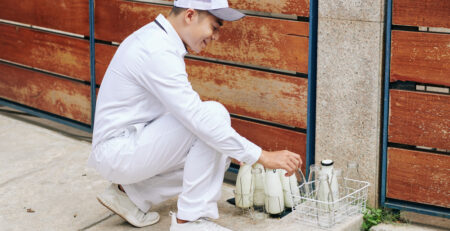Our biggest motivation when we first started designing Milk Topz was to do our bit to improve sustainability. We wanted to lower people’s plastic bottle output by encouraging glass bottle dairy deliveries. However, this created a conundrum, and led us to ask…
Just how sustainable is dairy?
Thankfully, the answer is: much more than it used to be!
Modern dairy-produced milk has a lower carbon footprint, uses less groundwater, and indeed, uses less land than milk did even back in the 1990s and 2000s.
Indeed, according to Dairy UK, the UK dairy industry is a world-leader in sustainability, with a cross-industry initiative called the UK dairy roadmap, started in 2008, delivering:
- A 24% cut in greenhouse gas emissions associated with milk production
- An 18% energy efficiency improvement
- A 24% upswing in water efficiency
- The landfill waste total reduced to just 4%;
- Recycling rates of plastic milk bottles improved to 85%.
All of these encouraging stats can be put down to the huge strides made in sustainable farming practices within the dairy industry. So we decided to look at different ways dairy farmers are becoming more sustainable.
Ways dairy is becoming more sustainable
There are a number of ways dairy farmers practice sustainability that contribute to better milk production…
1. Reusing waste
One of the best examples of the ways dairy farmers are becoming more sustainable lies in their planting of crops – and the way they feed them. Manure from cows can be composted and used to grow food – which is especially green if it’s injected below the soil, where methane emissions (and the smells from them) cannot escape into the atmosphere.
2. Saving on water
Dairy farms are getting better and better at recycling water. For instance, water used for cleaning the barns can be irrigated to feed the crops we’ve mentioned above, helping to lower the amount of freshwater used on each farm. On the whole, a single gallon of water can be used up to four times over on a dairy farm, vastly lowering the amount of new water being used and raising the sustainability factor of dairy farm considerably.
3. Improving animals using genetics
It’s common sense that the more milk dairy cows can produce, the less resources are needed to help farms reach a profitable output. And so, another example of how dairy is becoming more sustainable lies in farmers turning to artificial insemination to breed cows to the bull with the best genetics. This allows for rapid progress between generations and a quicker arrival at cows capable of producing larger amounts of milk.
4. Addressing animal welfare
It’s a commonly used adage that prevention is better than cure, and modern dairy farmers have taken that to heart. Milk production has been vastly improved by farmers taking proactive steps to prevent diseases through vaccination that could otherwise harm milk production. They also seek to keep dairy cows in better conditions, allowing them to exercise and lower the cow’s stress levels. All of these things improve productivity, lower the need for natural resources, and offer another example of how dairy is becoming more sustainable.
5. Improving cow’s nutritional intake
On the other side of the coin from general health of animals is their ongoing nutrition. Again, this is another way dairy farmers practice sustainability. Through correct cow nutrition, farmers can use a phenomenon called dilution of maintenance, farmers can ensure more of the nutrients consumed by their cows goes towards milk production, allowing that cattle to produce more product for less overall consumption.
6. Using renewable fuel sources
The last examples on our list of the ways dairy farmers practice sustainability is by using renewable energy sources. For instance, this dairy farm in Swindon has applied for planning permission to install 1,450 solar panels in order to generate power for its entire farm. Better still, any extra energy it creates will be funnelled back into the national grid, meaning this dairy farm is actually helping to create power for surrounding businesses and residences!
Are you looking to do your bit for dairy sustainability?
If you’re green-minded, you’ll love getting milk delivered by your local milkman – and using our reusable Milk Topz bottle caps to keep your milk tasting and smelling fresh for longer.
To learn more, see our Milk Topz products: our bright multi-colour pack or our cool pastel-coloured milk bottle tops.
For more on Milk Topz, milk storage or alternatives, and creatively delicious ways to use fresh milk, check out the blogs below!
Five Deliciously Milky Summer Treats to Make at Home
Five Fun Ways To Use Fresh Milk!






